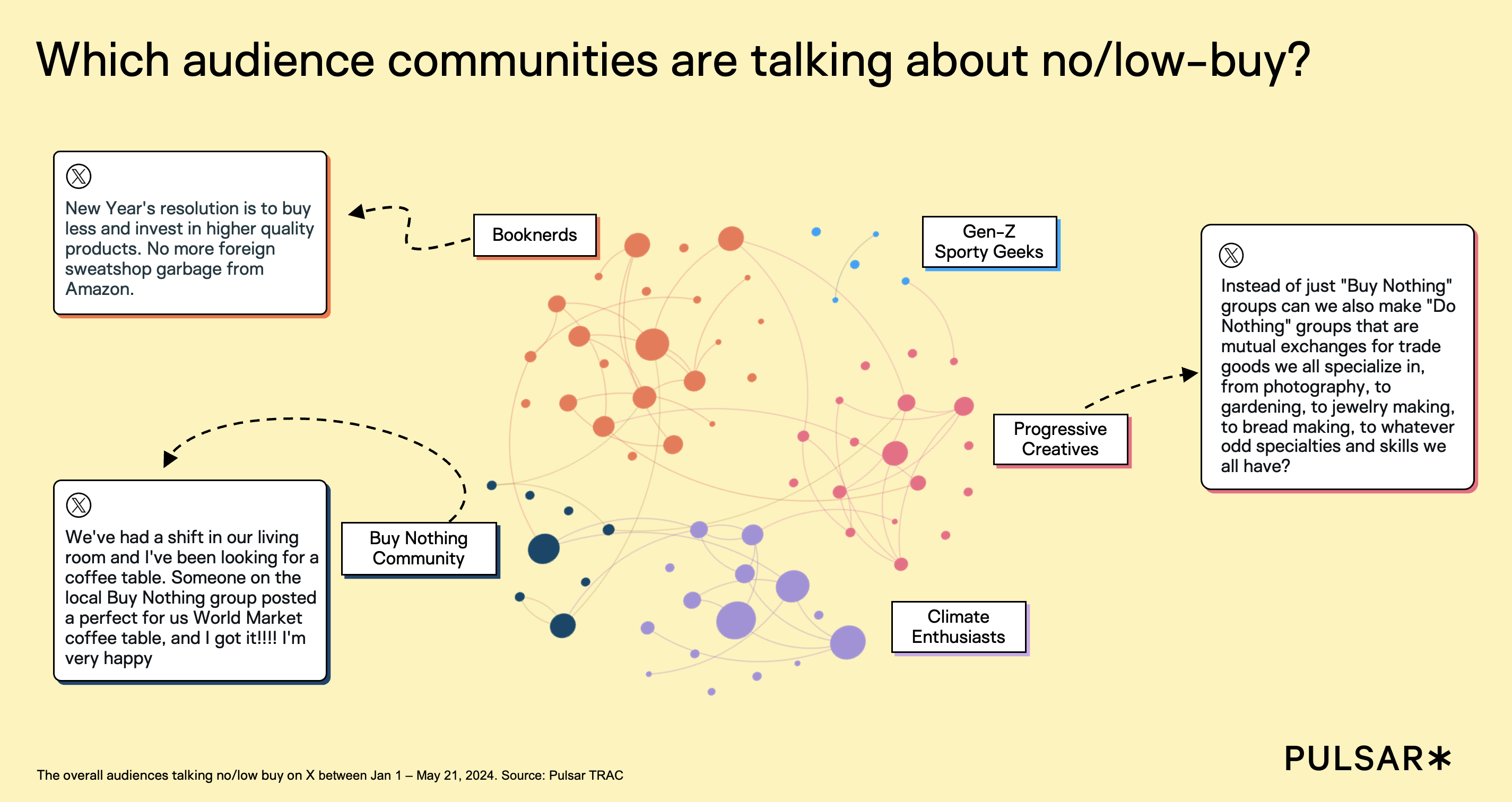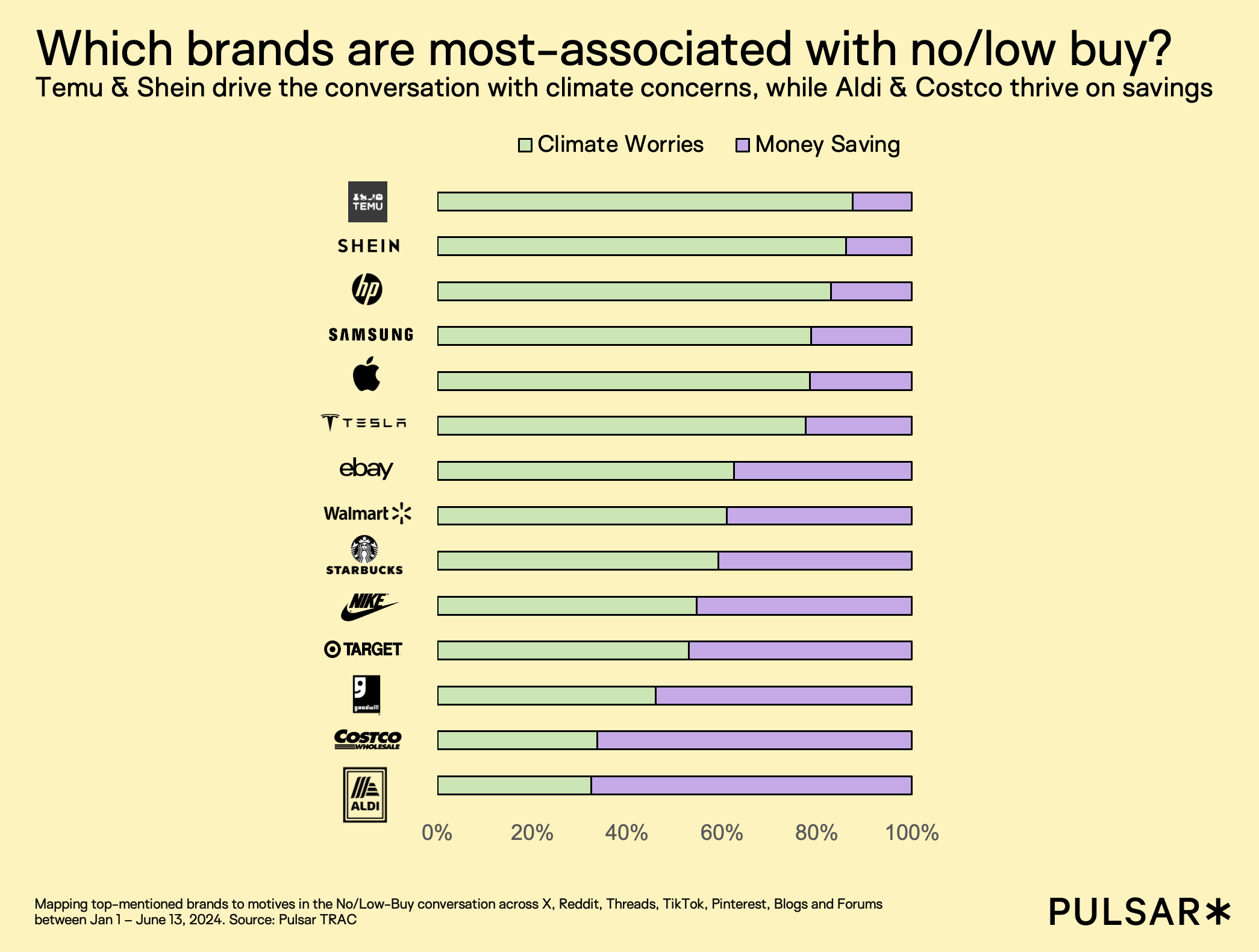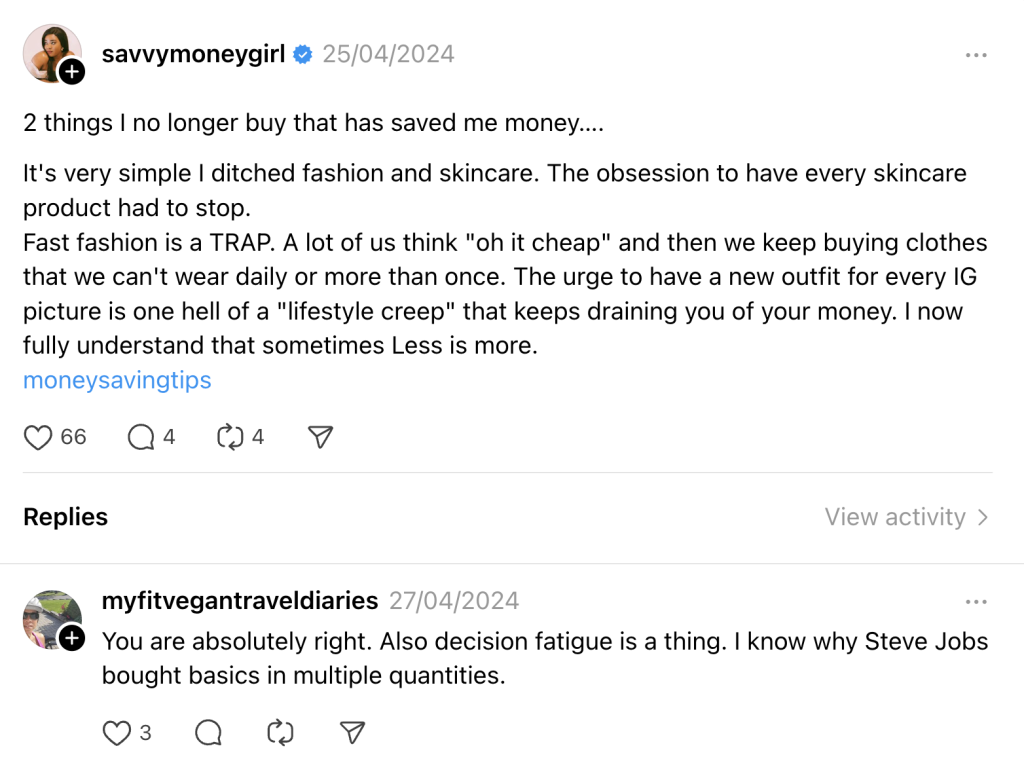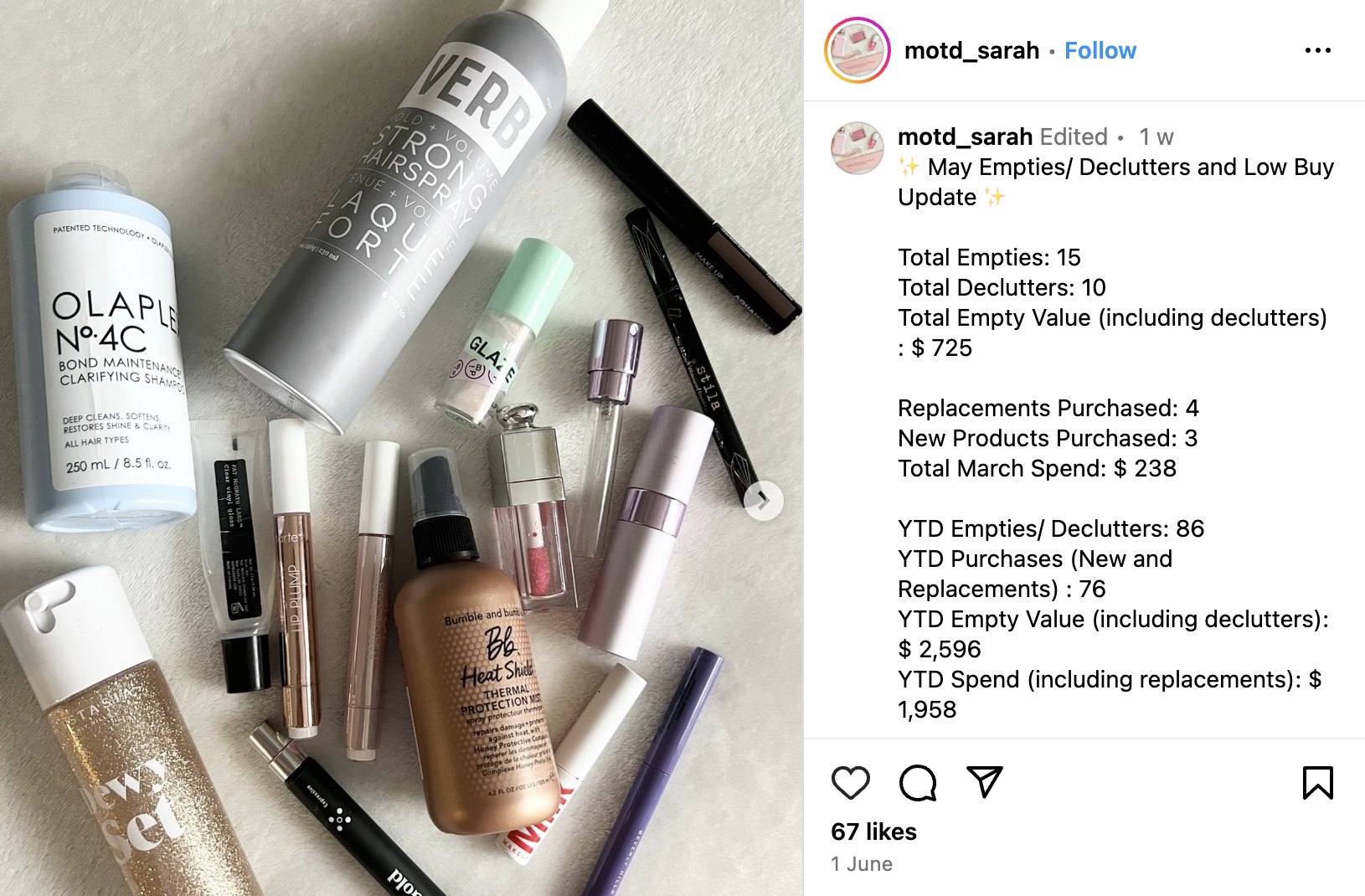
From de-influencing to no-buy, how audiences are embracing low-consumption trends
- FMCG
Is conspicuous consumption on its way out? As people adapt to rising economic and climate anxieties, a new set of ideas, attitudes and behaviors is emerging: they are a clean break from the influencer-driven consumerism and point to a new emerging relationship with society, the economy, citizenship, consumption, and the self.
This is the first of a series of articles which builds on our years-long investigation into the meaning of sustainability, and begins to map some of those new trends and how they intersect in unexpected ways.
In this blog, we'll be looking at:
Fad or Future? The Rise of Anti-Consumption Trends from Degrowth to Deinfluencing
Interest in degrowth has been growing steadily over the past few years as intellectuals, activists, and consumers alike have begun to question whether economic growth and consumption are necessary, good and desirable for human and planetary well-being.
The conversation –as often is the case with highly politicized ideas– includes plenty of criticism of course, with a coalition of various communities attacking the idea and its proponents from the right, center, and left: from traditional conservatives, to techno-optimists, to believers in ‘green growth’.
Degrowth propaganda is everywhere you look now
From Dutch news today:
"The Netherlands will have to get rid of the idea that electricity is available to everyone at all times"
They want us to go back to 1890? pic.twitter.com/ZvPmA5s9VO
— @levelsio (@levelsio) June 17, 2024
The debate around consumption though, is not just an ideological one. Younger communities, in particular, are embracing alternative consumption behaviors and turning them into a lifestyle focused on using and buying less.
The significance of this transition in consumption is highlighted by the prevalence of no- and low-buy trends as evidenced by data from Pulsar TRAC, which examined rich data points across X, TikTok, Reddit, Threads, Instagram, Pinterest, Tumblr, online news, blogs, and forums between January 1 and June 13, 2024.
The focal point of recent no-buy trends lies in the striking 106% surge in De-influencing, unveiling a nuanced alternative amidst the dichotomy of the no-buy and degrowth movements. This signals a growing affinity for subtle anti-consumption practices like decluttering and de-influencing, challenging the prevailing influence of influencer-driven and haul culture narratives such as TikTok Made Me Buy It
Ironically, the influence of de-influencers has intensified, as their recommendations shape perceptions of brands and social media, leading people to buy into their authenticity and community values. This triggered a backlash against influencer culture, leading anti-capitalist, sustainable, and frugal mindsets towards another enduring trend: decluttering.
Since 2019, Marie Kondo's influential book and Netflix series have inspired individuals to declutter and live more simply.
The “de-influencing” trend is such a breath of fresh air
byu/t3mp0rarys3cr3tary inGenZ
This intersects with the lower consumption trends nascent today. Marie Kondo going mainstream as she did was not perhaps, the quirky cultural artifact many perceived it as, but rather a moment that lived in concert with a shift in broader societal values. Clearly, there existed an audience primed to accept they owned too many ‘things’ - and that they could take direct action about it.
Which brings us to the No-Buy trend, which we can see as the other side of the coin to de-influencing, and a logical extension of decluttering: simply don’t purchase all the ‘stuff’ in the first place.
Unlike the politically-driven degrowth movement, no-buy concepts have been embraced as a money-saving challenge among younger demographics, accumulating 7M #nobuyyear posts on TikTok.
No-buy refers broadly to the pledge made by consumers to stop buying non-essential items, whether as a lasting lifestyle change, or to focus attention on the items that are really necessary.
So, which sectors do these movements center on?
New Frugality: The Motivations of No/Low Buy
No/low-buy isn’t a monolithic concept driven by a singular motive or purchasing factor. When we isolate two distinct motives in the conversation, frugality is gradually superseding sustainability.
This reflects broader consumer trends, as the cost-of-living crisis and economic certainty makes itself felt. Sustainability might have acted as springboard for no-buy behaviors, but frugality is ensuring a wider spread.
Even in the midst of a prevailing frugality mindset, however, it’s notable that consumers engaged in no-buy behaviors often articulate a positive narrative regarding their societal and environmental impact. Economic pragmatism is therefore combined with - and can underpin - conscientious consumption practices.
Reflective of this complexity, no/low buyers often take into account multiple factors when making purchases - or choosing not to.
Why I Bought My Tesla (twice) - and Why I Won’t Buy Another
byu/Afraid_Sample1688 inRealTesla
It’s not only the rationale which varies, of course, but also the actions taken by consumers. These resultant behaviors straddle the physical and digital world (rent and unfollow, for instance), as well the individual and communal spheres (repair and swap).
The most-discussed No/Low Buy tactics hint at the trajectory of this ongoing transformation.
The cultural cache of repairing items is growing amongst younger generations, as an increasingly sedentary, office-bound workforce show respect and affection for tasks previously viewed as mundane and low-skill.
Repairing in its modern form is also facilitated by thrifting and peer to peer resale platforms, as consumers choose to either purchase refurbished high-quality items, or else neglected items that it’s within their skillset to upcycle.
how Millennials vs. Gen Z describe items on resale sites
Millennial:
free gift for Buy Nothing Group, Aritzia sweatpants, needs repairGen Z:
Aritzia crotchless cargo jogger pants, bloquette, clean girl aesthetic, study outfit, fair condition, priced accordingly $10the pants: pic.twitter.com/LvtTmEVbEX
— Danielle Vermeer (@DLVermeer) May 8, 2024
Naturally, the ability of audiences to engage in repair-work is conditional on skill and available resources. Decluttering, in contrast, is a behavior open to the vast majority of society, and plays an important role in transitioning individuals from previous consumerist lifestyles to one’s predicated on No/low-buy principles.
This happens because acts of decluttering act as a breakpoint with existing behavioral patterns, insomuch as they involve some cost or material penalty, which makes the individual less likely to backtrack. At the same time, the proliferation of decluttering also creates a greater pool of goods for others to purchase as they think more carefully about their own consumer behavior.
Decluttering can extend to the digital world too - as individuals look to create buffer space between themselves and the digital spaces that act as conduits to the world of cheap, easily accessible goods.
I just needed to share this somewhere…..
byu/AshKash313 inbathandbodyworks
The Audiences of No/Low Buy

Progressive Creatives are a key driver of this trend - composed largely of Millennial Americans - the community are advocates of conscious consumption, tackling the proliferation of e-commerce, fast fashion, and plastic pollution.
Beyond holding up a mirror to these long-standing issues, they also encourage strategic approaches to no-buy behaviour such as #75Hard Style Challenge, in which users document their outfits for 75 days and, crucially, do not buy anything new.
Booknerds are a similarly large group, sharing many of the same age and geographic characteristics, - who engage in large scale No/Low-buy behavior, and reflect how the trend has picked up momentum amongst a certain cross-section of American consumer.
Climate Enthusiasts, meanwhile, are predictably most likely to hinge their No/low-buy activities around the idea of achieving an environmental goal, with much of their conversation focusing on not buying or consuming meat and dairy products.
Perhaps most interesting are the more niche communities, such as the Buy Nothing Community, a predominantly San Franciscan group who predicate more of their identity around the behavior. This community shares experiences, and fosters a culture of advice and resource sharing.
Comment
byu/jpedraza253 from discussion
inChoosingBeggars
The final community, Gen-Z Sporty Geeks, are the youngest and notable for finding joy in no-buy challenges, turning them into fun activities, with their own related memes and humor.
Takeaways for brands
So what does it mean for brands? When we map the most mentioned brands against the two major threads within the conversation, frugality and sustainability, some clear patterns emerge.

Temu & Shein frequently come up in discussions alongside climate concerns. Many participants in mindful and anti-consumption movements talk about reducing or eliminating purchases from these brands.
Conversely, it’s not surprising that frugal-minded audiences often mention supermarkets like Aldi and Costco in a positive light due to their competitive prices. If the climate and personal finance aspects of No/low-buy are often pulling in the same direction, this shines the light on a clear fissure within the movement - a competitively priced supermarket is likely to be viewed negatively, as a contributor towards unsustainable food practices, by one and positively, as an alleviator of hardship, by the other.
Perhaps most interestingly, on the subject of retailers, is the suggestion by some consumers that digital shopping platforms - often associated with impulsive behavior - can in fact support more deliberate, low-buy behavior.
anyone virtually shop because they save money over brick & mortar stores & impulse?
byu/erydanis inFrugal
Consumers who are increasingly used to interacting with the world through a screen, whether at work, in relationships or via shared experiences, are potentially more likely to feel themselves better able to make decisions that match their values in digital spaces over physical ones.
The notion that digital experiences facilitated by massive global companies might exist in partnership with the anti-consumerist espoused by many of these audiences might at first seem counter-intuitive. But it’s a theme that reoccurs throughout this conversation, from Netflix broadcasting Marie Kondo to a receptive audience, through to Facebook marketplace acting as a key site for sharers. No/low-buy behaviors is both a result of, and response to, this broader shifts in the consumer ecosystem.
This article was created using data from TRAC




